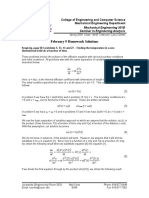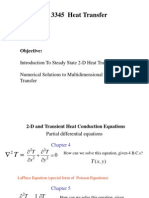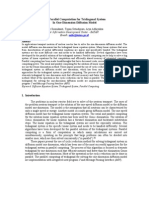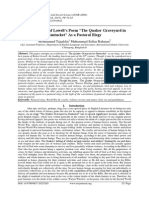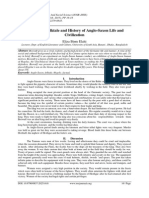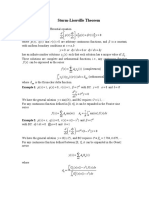Numerical Solution of Diffusion Equation by Finite Difference Method
Uploaded by
IOSRjournalNumerical Solution of Diffusion Equation by Finite Difference Method
Uploaded by
IOSRjournalIOSR Journal of Mathematics (IOSR-JM)
e-ISSN: 2278-5728, p-ISSN: 2319-765X. Volume 11, Issue 6 Ver. IV (Nov. - Dec. 2015), PP 19-25
www.iosrjournals.org
Numerical Solution of Diffusion Equation by Finite Difference
Method
1
M. M. Rahaman, 2M.M.H. Sikdar,3M. B. Hossain, 4M.A. Rahaman, 5M.Jamal.
Hossain
1,3
Associate Professor, Department of Mathematics, Patuakhali Science and Technology University,
Bangladesh,
2
Associate Professor, Department of Statistics, Patuakhali Scienceand Technology University, Bangladesh
4
Assistant Professor, Department of Computer Science and information Technology, Patuakhali Science and
Technology University, Bangladesh
5
Associate Professor, Department of Computer Science and information Technology, Patuakhali Science and
Technology University, Bangladesh
Abstract: In this work error estimation for numerical solution of Diffusion equation by finite difference method
is done. The Explicit centered difference scheme is described to find the numerical approximation of the
Diffusion equation. The numerical scheme is implemented in order to perform the numerical features of error
estimation. To get analytic solution, we present the variable separation method. We develop a computer
program to implement the finite difference method in scientific programming language. An example is used for
comparison; the numerical results are compared with analytical solutions.
Keywords: Analytic solution, Diffusion equation, Finite difference scheme, Initial value problem (IVP),
Relative error.
I.
Introduction
In Mathematics, the finite difference methods are numerical methods for approximating the
solutions to differential equations using finite difference equations to approximate derivatives. Our goal
is to approximate solutions to differential equations.i, e. to find a function (or some discrete
approximation to this functions) which satisfies a given relationship between several of its derivatives
on some given region of space /and or time, along with some boundary conditions along the edges of
this domain. A finite difference method proceeds by replacing the derivatives in the differential equation
by the finite difference approximations. This gives a large algebraic system of equations to be solved in
place of the differential equation, something that is easily solved on a computer.
In (A.N. Richmond, 2006), the authors develop the analytical solutions of nontrivial examples of a
wellknown class of initialboundary value problems which, by the choice of parameters, can be reduced to
regular or singular SturmLiouville problems. In (Sweilam et. al, 2012) the author presents the C-N-FDM to
solve the linear time fractional diffusion equation. They claimed that the C-N-FDM gives good results. The
authors studied the Spectral methods for solving the one dimensional parabolic heat equation (Juan- Gabriel et.
al 2006). In (Hikment Koyunbakan and Emrah Yilmaz, 2010), the Authors claimed that The ADM method is
more accurate. In (Subir et. al, 2011), the authors present the Adomian Decomposition method to solve the
nonlinear diffusion equation with fractional time derivatives. With the above discussion in view, our intention is
to investigate mathematical models, to establish the stability condition of the numerical scheme and to analyze
the error of the scheme.
In section 2, present a short discussion on the derivation of Diffusion equation as IBVP. In section 3,
the analytical solution of diffusion equation is illustrated by variable separation method. We describe an explicit
centered difference scheme for Diffusion equation as an IBVP with two sided boundary conditions in section 4.
In section 4, we also set up the stability condition of the numerical scheme. In section 5, we develop a computer
program in scientific programming language for the implementation of the numerical scheme and perform
numerical simulations in order to verify the behavior for various parameters. Finally the conclusions of the
paper are given in the last section.
II.
Governing Equation And Its Derivation:
In this study we consider the governing equation as IBVP
c
2c
D
t
x 2
DOI: 10.9790/5728-11641925
www.iosrjournals.org
19 | Page
Numerical Solution of Diffusion Equation by Finite Difference Method
c is the concentration at the point x at the time
time.
With appropriate initial and boundary condition
t , D is the diffusive constant in the x direction, t is the
c(t 0 , x) c0 ( x); a x b
c(t , a) ca (t ); t 0 t T
c(t , b) cb (t )
Consider the equation of mass conservation of the tracer. The continuity equation states that divergence of mass
flux equals change in mass in a control volume.
q
If we assume that
c
t
is constant in time and space, the continuity equation can be written as
c
t
Using Ficks law for q , we have a general Diffusion equation
Dc
c
t
If D is constant, the diffusion equation is given by as
D 2c
c
t
The diffusion coefficient theoretically is a tensor. However, for most cases, we assume it is a scalar. The
diffusion equation written in the Cartesian coordinate system in a one dimensional.
D
III.
2c
c
2
x
t
Analytical Solution Of The Governing Equation By The Method Of Variable Separation:
Consider c XT be the solution of the diffusion equation
c
2c
D 2
t
x
t0 t T
a xb
(1)
with the homogeneous boundary condition
Initial condition c( x,0) c0 , and boundary condition
Then
c(0, t ) 0 , c( L, t ) 0 , 0 x L
2c
c
c
XT ,
X T and 2 X T .
t
x
x
Now from the given equation, we have
T
X
DT
X
(2)
Each side of (2) must be constant,
T
X
2 (say)
DT
X
DOI: 10.9790/5728-11641925
www.iosrjournals.org
20 | Page
Numerical Solution of Diffusion Equation by Finite Difference Method
Then T D T 0 and X X 0 whose solution are,
2
T C1e D t and X A1 cos x B1 sin x
2
Thus a solution of the partial differential equation is
c( x, t ) ( A1 cos x B1 sin x)C1e D t e D t ( A cos x B sin x)
2
(3)
Applying the boundary condition
c(0, t ) 0 , 0 Ae D t
2
Since
A 0 , since e D t 0 .
2
Thus from (3), we have
c( x, t ) Be D t sin x
2
(4)
c( L, t ) 0 , 0 Be D t sin L
2
Since
B0
If
the
solution
sin L 0 since B 0 , e D t
2
is
identically
zero,
n
, n 0,1,2,
0
L
so
we
must
have
By the principle of superposition
The solution is
c( x, t ) Bn e
n 2 2
L2
Dt
sin
n 1
n
x
L
(5)
In order to satisfy the last condition,
c( x,0) Bn sin
n 1
n
x
L
2
n
Using Fourier series, Bn c( x,0) sin
xdx
L0
L
L
The solution of the governing equation can be written as follows
2
n
c( x, t ) ( c( x,0) sin
xdx )e
L
n 1 L 0
DOI: 10.9790/5728-11641925
n 2 2
L2
Dt
sin
n
x
L
www.iosrjournals.org
(6)
21 | Page
Numerical Solution of Diffusion Equation by Finite Difference Method
IV. Formulation Of The Diffusion Equation
We would like to consider the diffusion equation as an initial and homogeneous boundary value
problem
c
2c
D 2 , t0 t T , a x b
t
x
Initial condition c( x,0) c0 , and boundary condition c(0, t ) 0 , c( L, t ) 0
In order to develop the scheme, we discretize the x t plane by choosing a mesh width h x space and a
time step k t . The finite difference methods we will develop produce approximations ci R
n
solution
to the
c( xi , t n ) at the discrete points by
xi ih
i 0,1,2,3.....
t n nk , n 0,1,2,3.....
Let the solution
c( xi , t n ) be denoted by C in and its approximate value by cin .
Simple approximations to the first derivative in the time direction by forward difference can be obtained from
c Cin 1 Cin
o(t )
t
t
2c
Discretization of
is obtain from second order central difference in space.
x 2
2 c Cin1 2Cin Cin1
o(x 2 )
2
2
x
x
We obtain
Cin 1 Cin
C n 2Cin Cin1
D i 1
o(t x 2 )
2
t
x
The terms o(t x
the difference methods
n 1
=> ci
(7)
) denote the order of the method. Neglecting the error terms and simplifying. We obtain
Dt n
Dt
Dt
c (1 2 2 )cin 2 cin1
2 i 1
x
x
x
(8)
This is the required explicit centered difference scheme for the IBVP
cin1 cin1 (1 2 )cin cin1
(9)
This scheme uses a second order central difference in space and the first order forward Euler scheme in time.
Where
Dt
1
Note that if 0 , then the solution at the new time is a weighted average of the
2
2
x
solution at the old time .This implies a discrete maximum principle, and therefore numerical stability. It also
implies monotonocity: if
cin1 cin
for all i , then
cin11 cin1 (cin cin1 ) (1 2 )(cin1 cin ) (cin2 cin1 ) 0
However, we must choose the time step to be small: we must have
1
x 2
, or equivalently that t
2
2D
This time step restriction typically requires an unacceptably large number of time steps, unless the diffusion
constant D is very small.
4.1 Stability of the explicit centered difference scheme (8) is given by the conditions 0
DOI: 10.9790/5728-11641925
www.iosrjournals.org
Dt 1
x 2 2
22 | Page
Numerical Solution of Diffusion Equation by Finite Difference Method
Proof: The explicit centered difference scheme (8) takes the form
n 1
=> ci
Dt n
Dt
Dt
c (1 2 2 )cin 2 cin1
2 i 1
x
x
x
cin1 cin1 (1 2 )cin cin1
Where
(10)
Dt
x 2
The equation (10) implies that if 0
1
, and then the solution at the new time is a weighted average of the
2
solution at the old time. This implies a discrete maximum principle. We can conclude that the explicit centered
difference scheme (10) is stable for
0 D
V.
t
1
2
2
x
Error Estimation Of The Scheme:
In order to perform error estimation, we consider the exact solution of the model equation with initial condition
c( x,0) c0 ( x) x(1 x) and homogeneous boundary condition. We get
2
n
c( x, t ) ( c( x,0) sin
xdx )e
L
n 1 L 0
n 2 2
L2
Dt
sin
n
x
L
We compute the error defined by
e
for all time where
Ce C N
Ce
ce
is the exact solution and
c N is the Numerical solution computed by the finite difference
scheme.
5.1Results And Discussion:
We solve the diffusion equation by implementing the centered difference scheme, while varying the
different parameter values.
Figure 1: The behavior of numerical solution at D 0.001m 2 / s , 0.005m 2 / s .
DOI: 10.9790/5728-11641925
www.iosrjournals.org
23 | Page
Numerical Solution of Diffusion Equation by Finite Difference Method
Concentration distribution for each diffusion rate at time t=24 min. In figure-1, the profile for varying
contaminant diffusion rate, we saw that the contaminant concentration with a higher diffusion rate decreases at a
higher rate than that with a lower diffusion rate. The curve marked by star shows the concentration profile for
diffusion rate D 0.001m 2 / s and the curve visible by dot line represents the concentration profile for
diffusion rate D 0.005m 2 / s
Figure 2: Analytic solution and Numerical solution at different time Analytical solution of diffusion equation is
compared with the numerical solution at different time in figure-2. The curve noticeable by blue line shows
the numerical solution, the curve visible by red line represents numerical solution. The results are very close.
Figure 3: The Numerical solution and Analytical solution in mesh.
Figure 4: The error in the numerical result is shown for x=0.1
DOI: 10.9790/5728-11641925
www.iosrjournals.org
24 | Page
Numerical Solution of Diffusion Equation by Finite Difference Method
Figure 5: The error in the numerical result is shown for x=0.01
Figure-4 and figure-5 shows the error in the numerical solution from each of the methods when
compared with the analytical solution, for the atwo cases N=10, N=100, corresponding to x=0.1, 0.01
respectively. Comparisons are made for the solution at different time for smaller x the errors reduce in size.
The errors for the central difference scheme decrease as the grid size decrease.
VI. Conclusion:
The study has presented the numerical and analytical solution of Diffusion equation. The explicit
centered difference scheme is used in order to perform the numerical features of error estimation. We have seen
that the contaminant concentration with a higher diffusion rate decreases at a higher rate than that with a lower
diffusion rate. In order to execute the numerical method we have developed a computer program in the language
of scientific computing that is a very good agreement of the finite difference method for Diffusion equation.
Reference
[1].
A.N. Richmond (2006, July), Analytical solution of a class of diffusion problems, International journal of mathematical education
in Science and Technology, Vol.15, issue 5, p. 643-648.
[2].
N. H. Sweilam, M. M. Khader, A. M. S. Mahdy ( 2012, Jan.), Crack Nicolson finite difference method for solving time-fractional
diffusion equation, Journal of Fractional Calculus and Application, Vol. 2, No. 2, pp. 1-9.
[3].
[4].
[5].
[6].
Collatz, L. (1960), The Numerical Treatment of Differential Equation, 3rd ed., Springer- Verlag, Berlin.
Randall J. LeVeque (1992), Numerical methods for conservation laws, Second edition, Springer.
John A.Trangestein (2000), Numerical Solution of Partial Differential Equation, Durham.
L.S.Andallah (2008), Finite Difference Method-Explicit Upwind Difference Scheme, lecturer note, Department of Mathematics,
Jahangirnagar University.
Juan- Gabriel, Barbosa- Saldana, Jose- Alfredo Jimenez Bernal, Claudia (2006), Numerical Solution for the One Dimensional Heat
Equation by a Pseudo Spectral Discretization Technique, Cientifica Vol. 10, No. 1, pp. 3-8, ESIME-IPN, Impreso en Mexico.
M.K.Jain,S.R.K.Iyengar,R.K.Jain,Computational Methods for Partial Differential Equations, Book published by New Age
International (p) Ltd, Reprint: 2007.
Hikment Koyunbakan and Emrah Yilmaz,Numerical Simulation of Diffusion Equation by Means of Hes Variational Iteration
Methods and Adominas Decomposition method , Cankaya University Journal of Science and Engineering, Vol. 7, No. 1, 25-38,
2010.
Subir Das, Praveen Kumer Kupta, Pradyumna Ghosh An Approximate analytic Solution of Non Linear Fractional Diffusion
Equation, International Journal of Nonlinear science, 2011, Vol.12, No.3, pp.339-346.
S.B.Yuste and L.Acedo An explicit finite difference method and a new VonNumann-type stability analysis for fractional diffusion
equations,
2005
society
for
industrial
and
applied
Mathematics,vol.42,
No.
5,
pp.1862-1874.
Gerald W. Rectenwald Finite difference approximations to the heat equation, March 9, 2011.
[7].
[8].
[9].
[10].
[11].
[12].
[13].
[14].
[15].
D.V. Widder, The heat equation. Academic Press, 1975.
N.Azizi, R. Pourgholi and M. Ebrahimi, Application of finite difference method to estimation of diffusion coefficient in a one
dimensional nonlinear inverse diffusion problem.
Rama Cont and Ekaterina Voltchkova A finite difference scheme for option princing in jump diffusion and exponential levy
models, ECCOMAS 2004.
S.S.Sastry, Introductory Methods of Numerical Analysis, Fourth edition, 2007. T.Papakostas, A.G.Bratsos, I.Th.Famelis, A.I.Dlis
and D.G.Natsis, An implicit numerical scheme for the atmospheric pollution.
DOI: 10.9790/5728-11641925
www.iosrjournals.org
25 | Page
You might also like
- Finite Difference Method On Non-Uniform Meshes For Time Fractional Diffusion ProblemNo ratings yetFinite Difference Method On Non-Uniform Meshes For Time Fractional Diffusion Problem14 pages
- Analytical Solutions To Two-Dimensional D@usion Type Problems in H-Regular GeometriesNo ratings yetAnalytical Solutions To Two-Dimensional D@usion Type Problems in H-Regular Geometries14 pages
- Directional Secant Method For Nonlinear Equations: Heng-Bin An, Zhong-Zhi BaiNo ratings yetDirectional Secant Method For Nonlinear Equations: Heng-Bin An, Zhong-Zhi Bai14 pages
- A Fractional Order Collocation Method For Second Kind Volterra Integral Equations With Weakly Singular KernelsNo ratings yetA Fractional Order Collocation Method For Second Kind Volterra Integral Equations With Weakly Singular Kernels23 pages
- Finite-Difference Approximations To The Heat EquationNo ratings yetFinite-Difference Approximations To The Heat Equation27 pages
- Finite Different Method - Heat Transfer - Using MatlabNo ratings yetFinite Different Method - Heat Transfer - Using Matlab27 pages
- Computation of Periodic Solutions of Conservative Systems With Application To The 3-Body ProblemNo ratings yetComputation of Periodic Solutions of Conservative Systems With Application To The 3-Body Problem29 pages
- The Numerical Solution of Fractional Differential EquationsNo ratings yetThe Numerical Solution of Fractional Differential Equations14 pages
- Convergence of A High-Order Compact Finite Difference Scheme For A Nonlinear Black-Scholes EquationNo ratings yetConvergence of A High-Order Compact Finite Difference Scheme For A Nonlinear Black-Scholes Equation16 pages
- A Genuinely High Order Total Variation Diminishing Scheme For One-Dimensional Scalar Conservation LawsNo ratings yetA Genuinely High Order Total Variation Diminishing Scheme For One-Dimensional Scalar Conservation Laws24 pages
- Solving Differential Riccati Equations A NonlinearNo ratings yetSolving Differential Riccati Equations A Nonlinear20 pages
- On New Iterative Methods For Numerical Solution of Higher-Order Parametric Differetial EquationsNo ratings yetOn New Iterative Methods For Numerical Solution of Higher-Order Parametric Differetial Equations11 pages
- MATH3203 Lecture 5 Accuracy of Finite Difference Schemes: Dion WeatherleyNo ratings yetMATH3203 Lecture 5 Accuracy of Finite Difference Schemes: Dion Weatherley6 pages
- Received 10 April 1997. Read 16 March 1997. Published 30 December 1998.No ratings yetReceived 10 April 1997. Read 16 March 1997. Published 30 December 1998.18 pages
- Seismic Source Inversion Using Discontinuous Galerkin Methods A Bayesian ApproachNo ratings yetSeismic Source Inversion Using Discontinuous Galerkin Methods A Bayesian Approach16 pages
- Drift-Diffusion Model: Introduction: Dragica VasileskaNo ratings yetDrift-Diffusion Model: Introduction: Dragica Vasileska9 pages
- Iterative Methods of Richardson-Lucy-type For Image DeblurringNo ratings yetIterative Methods of Richardson-Lucy-type For Image Deblurring15 pages
- An Efficient High-Order Algorithm For Scattering by Inhomogeneous Penetrable MediaNo ratings yetAn Efficient High-Order Algorithm For Scattering by Inhomogeneous Penetrable Media206 pages
- Chapter 9 Factorising and DL Using A Factor BaseNo ratings yetChapter 9 Factorising and DL Using A Factor Base11 pages
- The Parallel Computation For Tridiagonal System in One-Dimension Diffusion ModelNo ratings yetThe Parallel Computation For Tridiagonal System in One-Dimension Diffusion Model9 pages
- 21.E Cient Massively Parallel Implementation of The RNo ratings yet21.E Cient Massively Parallel Implementation of The R16 pages
- Distance-Redshift Relations in An Anisotropic Cosmological ModelNo ratings yetDistance-Redshift Relations in An Anisotropic Cosmological Model8 pages
- Differential Systems Exactly Solved by Multistep Finite Difference SchemesNo ratings yetDifferential Systems Exactly Solved by Multistep Finite Difference Schemes11 pages
- Primal-Dual Interior Point Method ReportNo ratings yetPrimal-Dual Interior Point Method Report8 pages
- Numerical Solution of Batch Crystallization Models: Qamar S., Seidel-Morgenstern ANo ratings yetNumerical Solution of Batch Crystallization Models: Qamar S., Seidel-Morgenstern A6 pages
- Digital Signal and Image Processing using MATLAB, Volume 3: Advances and Applications, The Stochastic CaseFrom EverandDigital Signal and Image Processing using MATLAB, Volume 3: Advances and Applications, The Stochastic Case3/5 (1)
- "I Am Not Gay Says A Gay Christian." A Qualitative Study On Beliefs and Prejudices of Christians Towards Homosexuality in ZimbabweNo ratings yet"I Am Not Gay Says A Gay Christian." A Qualitative Study On Beliefs and Prejudices of Christians Towards Homosexuality in Zimbabwe5 pages
- A Review of Rural Local Government System in Zimbabwe From 1980 To 2014No ratings yetA Review of Rural Local Government System in Zimbabwe From 1980 To 201415 pages
- The Role of Extrovert and Introvert Personality in Second Language AcquisitionNo ratings yetThe Role of Extrovert and Introvert Personality in Second Language Acquisition6 pages
- Socio-Ethical Impact of Turkish Dramas On Educated Females of Gujranwala-PakistanNo ratings yetSocio-Ethical Impact of Turkish Dramas On Educated Females of Gujranwala-Pakistan7 pages
- An Evaluation of Lowell's Poem "The Quaker Graveyard in Nantucket" As A Pastoral ElegyNo ratings yetAn Evaluation of Lowell's Poem "The Quaker Graveyard in Nantucket" As A Pastoral Elegy14 pages
- Attitude and Perceptions of University Students in Zimbabwe Towards HomosexualityNo ratings yetAttitude and Perceptions of University Students in Zimbabwe Towards Homosexuality5 pages
- The Impact of Technologies On Society: A Review100% (1)The Impact of Technologies On Society: A Review5 pages
- A Proposed Framework On Working With Parents of Children With Special Needs in SingaporeNo ratings yetA Proposed Framework On Working With Parents of Children With Special Needs in Singapore7 pages
- Assessment of The Implementation of Federal Character in Nigeria.No ratings yetAssessment of The Implementation of Federal Character in Nigeria.5 pages
- Topic: Using Wiki To Improve Students' Academic Writing in English Collaboratively: A Case Study On Undergraduate Students in BangladeshNo ratings yetTopic: Using Wiki To Improve Students' Academic Writing in English Collaboratively: A Case Study On Undergraduate Students in Bangladesh7 pages
- Investigation of Unbelief and Faith in The Islam According To The Statement, Mr. Ahmed MoftizadehNo ratings yetInvestigation of Unbelief and Faith in The Islam According To The Statement, Mr. Ahmed Moftizadeh4 pages
- An Exploration On The Relationship Among Learners' Autonomy, Language Learning Strategies and Big-Five Personality TraitsNo ratings yetAn Exploration On The Relationship Among Learners' Autonomy, Language Learning Strategies and Big-Five Personality Traits6 pages
- Comparative Visual Analysis of Symbolic and Illegible Indus Valley Script With Other LanguagesNo ratings yetComparative Visual Analysis of Symbolic and Illegible Indus Valley Script With Other Languages7 pages
- Importance of Mass Media in Communicating Health Messages: An AnalysisNo ratings yetImportance of Mass Media in Communicating Health Messages: An Analysis6 pages
- Classical Malay's Anthropomorphemic Metaphors in Essay of Hikajat AbdullahNo ratings yetClassical Malay's Anthropomorphemic Metaphors in Essay of Hikajat Abdullah9 pages
- Edward Albee and His Mother Characters: An Analysis of Selected PlaysNo ratings yetEdward Albee and His Mother Characters: An Analysis of Selected Plays5 pages
- Relationship Between Social Support and Self-Esteem of Adolescent GirlsNo ratings yetRelationship Between Social Support and Self-Esteem of Adolescent Girls5 pages
- Role of Madarsa Education in Empowerment of Muslims in IndiaNo ratings yetRole of Madarsa Education in Empowerment of Muslims in India6 pages
- Beowulf: A Folktale and History of Anglo-Saxon Life and CivilizationNo ratings yetBeowulf: A Folktale and History of Anglo-Saxon Life and Civilization3 pages
- Human Rights and Dalits: Different Strands in The DiscourseNo ratings yetHuman Rights and Dalits: Different Strands in The Discourse5 pages
- Designing of Indo-Western Garments Influenced From Different Indian Classical Dance CostumesNo ratings yetDesigning of Indo-Western Garments Influenced From Different Indian Classical Dance Costumes5 pages
- Design Management, A Business Tools' Package of Corporate Organizations: Bangladesh ContextNo ratings yetDesign Management, A Business Tools' Package of Corporate Organizations: Bangladesh Context6 pages
- Micro Finance and Women - A Case Study of Villages Around Alibaug, District-Raigad, Maharashtra, IndiaNo ratings yetMicro Finance and Women - A Case Study of Villages Around Alibaug, District-Raigad, Maharashtra, India3 pages
- Mathematical Biology Assignment1 MichaelgbonehNo ratings yetMathematical Biology Assignment1 Michaelgboneh4 pages
- Discrete Math 02 - Inference Rule and ProofsNo ratings yetDiscrete Math 02 - Inference Rule and Proofs40 pages
- (Artigo) Anellis, I. H. Jean Van Heijenoort Contributions To ProveNo ratings yet(Artigo) Anellis, I. H. Jean Van Heijenoort Contributions To Prove24 pages
- 2.07) Add Math Module 07 (Simultaneous Equations)No ratings yet2.07) Add Math Module 07 (Simultaneous Equations)10 pages
- Determine Whether Lines Are Parallel or PerpendicularNo ratings yetDetermine Whether Lines Are Parallel or Perpendicular5 pages
- Math 26 Z: Analytic Geometry and The Conic SectionsNo ratings yetMath 26 Z: Analytic Geometry and The Conic Sections6 pages
- A Defense of A Principle of Sufficient Reason - SmithNo ratings yetA Defense of A Principle of Sufficient Reason - Smith10 pages
- 3.4.1 The Logic of Quantified Statements Part 4.1 PDFNo ratings yet3.4.1 The Logic of Quantified Statements Part 4.1 PDF39 pages
- Finite Difference Method On Non-Uniform Meshes For Time Fractional Diffusion ProblemFinite Difference Method On Non-Uniform Meshes For Time Fractional Diffusion Problem
- Analytical Solutions To Two-Dimensional D@usion Type Problems in H-Regular GeometriesAnalytical Solutions To Two-Dimensional D@usion Type Problems in H-Regular Geometries
- Directional Secant Method For Nonlinear Equations: Heng-Bin An, Zhong-Zhi BaiDirectional Secant Method For Nonlinear Equations: Heng-Bin An, Zhong-Zhi Bai
- A Fractional Order Collocation Method For Second Kind Volterra Integral Equations With Weakly Singular KernelsA Fractional Order Collocation Method For Second Kind Volterra Integral Equations With Weakly Singular Kernels
- Finite-Difference Approximations To The Heat EquationFinite-Difference Approximations To The Heat Equation
- Finite Different Method - Heat Transfer - Using MatlabFinite Different Method - Heat Transfer - Using Matlab
- Computation of Periodic Solutions of Conservative Systems With Application To The 3-Body ProblemComputation of Periodic Solutions of Conservative Systems With Application To The 3-Body Problem
- The Numerical Solution of Fractional Differential EquationsThe Numerical Solution of Fractional Differential Equations
- Convergence of A High-Order Compact Finite Difference Scheme For A Nonlinear Black-Scholes EquationConvergence of A High-Order Compact Finite Difference Scheme For A Nonlinear Black-Scholes Equation
- A Genuinely High Order Total Variation Diminishing Scheme For One-Dimensional Scalar Conservation LawsA Genuinely High Order Total Variation Diminishing Scheme For One-Dimensional Scalar Conservation Laws
- Solving Differential Riccati Equations A NonlinearSolving Differential Riccati Equations A Nonlinear
- On New Iterative Methods For Numerical Solution of Higher-Order Parametric Differetial EquationsOn New Iterative Methods For Numerical Solution of Higher-Order Parametric Differetial Equations
- MATH3203 Lecture 5 Accuracy of Finite Difference Schemes: Dion WeatherleyMATH3203 Lecture 5 Accuracy of Finite Difference Schemes: Dion Weatherley
- Received 10 April 1997. Read 16 March 1997. Published 30 December 1998.Received 10 April 1997. Read 16 March 1997. Published 30 December 1998.
- Seismic Source Inversion Using Discontinuous Galerkin Methods A Bayesian ApproachSeismic Source Inversion Using Discontinuous Galerkin Methods A Bayesian Approach
- Drift-Diffusion Model: Introduction: Dragica VasileskaDrift-Diffusion Model: Introduction: Dragica Vasileska
- Iterative Methods of Richardson-Lucy-type For Image DeblurringIterative Methods of Richardson-Lucy-type For Image Deblurring
- An Efficient High-Order Algorithm For Scattering by Inhomogeneous Penetrable MediaAn Efficient High-Order Algorithm For Scattering by Inhomogeneous Penetrable Media
- The Parallel Computation For Tridiagonal System in One-Dimension Diffusion ModelThe Parallel Computation For Tridiagonal System in One-Dimension Diffusion Model
- 21.E Cient Massively Parallel Implementation of The R21.E Cient Massively Parallel Implementation of The R
- Distance-Redshift Relations in An Anisotropic Cosmological ModelDistance-Redshift Relations in An Anisotropic Cosmological Model
- Differential Systems Exactly Solved by Multistep Finite Difference SchemesDifferential Systems Exactly Solved by Multistep Finite Difference Schemes
- Numerical Solution of Batch Crystallization Models: Qamar S., Seidel-Morgenstern ANumerical Solution of Batch Crystallization Models: Qamar S., Seidel-Morgenstern A
- Solution of Certain Problems in Quantum MechanicsFrom EverandSolution of Certain Problems in Quantum Mechanics
- A-level Maths Revision: Cheeky Revision ShortcutsFrom EverandA-level Maths Revision: Cheeky Revision Shortcuts
- Digital Signal Processing (DSP) with Python ProgrammingFrom EverandDigital Signal Processing (DSP) with Python Programming
- Constructed Layered Systems: Measurements and AnalysisFrom EverandConstructed Layered Systems: Measurements and Analysis
- Digital Signal and Image Processing using MATLAB, Volume 3: Advances and Applications, The Stochastic CaseFrom EverandDigital Signal and Image Processing using MATLAB, Volume 3: Advances and Applications, The Stochastic Case
- "I Am Not Gay Says A Gay Christian." A Qualitative Study On Beliefs and Prejudices of Christians Towards Homosexuality in Zimbabwe"I Am Not Gay Says A Gay Christian." A Qualitative Study On Beliefs and Prejudices of Christians Towards Homosexuality in Zimbabwe
- A Review of Rural Local Government System in Zimbabwe From 1980 To 2014A Review of Rural Local Government System in Zimbabwe From 1980 To 2014
- The Role of Extrovert and Introvert Personality in Second Language AcquisitionThe Role of Extrovert and Introvert Personality in Second Language Acquisition
- Socio-Ethical Impact of Turkish Dramas On Educated Females of Gujranwala-PakistanSocio-Ethical Impact of Turkish Dramas On Educated Females of Gujranwala-Pakistan
- An Evaluation of Lowell's Poem "The Quaker Graveyard in Nantucket" As A Pastoral ElegyAn Evaluation of Lowell's Poem "The Quaker Graveyard in Nantucket" As A Pastoral Elegy
- Attitude and Perceptions of University Students in Zimbabwe Towards HomosexualityAttitude and Perceptions of University Students in Zimbabwe Towards Homosexuality
- A Proposed Framework On Working With Parents of Children With Special Needs in SingaporeA Proposed Framework On Working With Parents of Children With Special Needs in Singapore
- Assessment of The Implementation of Federal Character in Nigeria.Assessment of The Implementation of Federal Character in Nigeria.
- Topic: Using Wiki To Improve Students' Academic Writing in English Collaboratively: A Case Study On Undergraduate Students in BangladeshTopic: Using Wiki To Improve Students' Academic Writing in English Collaboratively: A Case Study On Undergraduate Students in Bangladesh
- Investigation of Unbelief and Faith in The Islam According To The Statement, Mr. Ahmed MoftizadehInvestigation of Unbelief and Faith in The Islam According To The Statement, Mr. Ahmed Moftizadeh
- An Exploration On The Relationship Among Learners' Autonomy, Language Learning Strategies and Big-Five Personality TraitsAn Exploration On The Relationship Among Learners' Autonomy, Language Learning Strategies and Big-Five Personality Traits
- Comparative Visual Analysis of Symbolic and Illegible Indus Valley Script With Other LanguagesComparative Visual Analysis of Symbolic and Illegible Indus Valley Script With Other Languages
- Importance of Mass Media in Communicating Health Messages: An AnalysisImportance of Mass Media in Communicating Health Messages: An Analysis
- Classical Malay's Anthropomorphemic Metaphors in Essay of Hikajat AbdullahClassical Malay's Anthropomorphemic Metaphors in Essay of Hikajat Abdullah
- Edward Albee and His Mother Characters: An Analysis of Selected PlaysEdward Albee and His Mother Characters: An Analysis of Selected Plays
- Relationship Between Social Support and Self-Esteem of Adolescent GirlsRelationship Between Social Support and Self-Esteem of Adolescent Girls
- Role of Madarsa Education in Empowerment of Muslims in IndiaRole of Madarsa Education in Empowerment of Muslims in India
- Beowulf: A Folktale and History of Anglo-Saxon Life and CivilizationBeowulf: A Folktale and History of Anglo-Saxon Life and Civilization
- Human Rights and Dalits: Different Strands in The DiscourseHuman Rights and Dalits: Different Strands in The Discourse
- Designing of Indo-Western Garments Influenced From Different Indian Classical Dance CostumesDesigning of Indo-Western Garments Influenced From Different Indian Classical Dance Costumes
- Design Management, A Business Tools' Package of Corporate Organizations: Bangladesh ContextDesign Management, A Business Tools' Package of Corporate Organizations: Bangladesh Context
- Micro Finance and Women - A Case Study of Villages Around Alibaug, District-Raigad, Maharashtra, IndiaMicro Finance and Women - A Case Study of Villages Around Alibaug, District-Raigad, Maharashtra, India
- (Artigo) Anellis, I. H. Jean Van Heijenoort Contributions To Prove(Artigo) Anellis, I. H. Jean Van Heijenoort Contributions To Prove
- Determine Whether Lines Are Parallel or PerpendicularDetermine Whether Lines Are Parallel or Perpendicular
- Math 26 Z: Analytic Geometry and The Conic SectionsMath 26 Z: Analytic Geometry and The Conic Sections
- A Defense of A Principle of Sufficient Reason - SmithA Defense of A Principle of Sufficient Reason - Smith
- 3.4.1 The Logic of Quantified Statements Part 4.1 PDF3.4.1 The Logic of Quantified Statements Part 4.1 PDF















